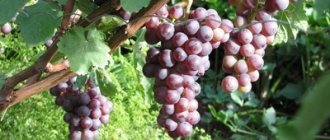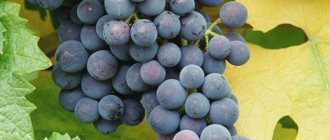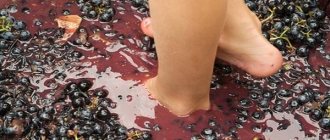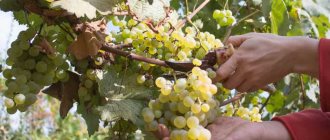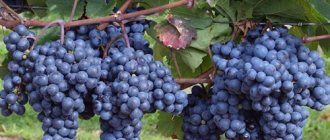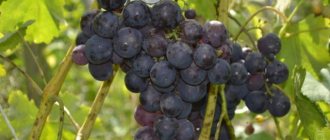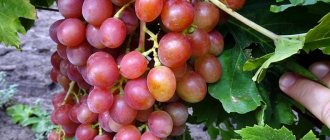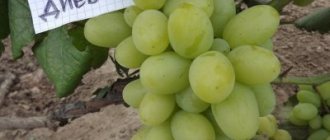Description of the Gourmet variety
Gourmand, like all its varieties, is a table variety.
These are pink grapes, early ripening. It has a very beautiful appearance and excellent taste.
Pink varieties also include Angelica, Gurzufsky pink and Flamingo.
Useful properties and use
In addition to vitamins and minerals, pink grapes contain large quantities of biologically active substances, the benefits of which are invaluable for human health.
| Active substance | Useful property |
| Dihydroquercetin | Restores the structure of the walls of capillaries and blood vessels. Restores oxygen microcirculation in tissues. Normalizes normal blood flow. |
| Anthocyanins (natural colorants) | Protect from UV radiation. Fight cancer cells. They have anti-inflammatory properties. |
| Catechins | They fight the aging process of the body. Protect from radiation. |
| Tannins | Removes toxins and heavy metal salts. They are a natural antiseptic. |
Reference! The calorie content of early gourmand grapes is 69 kcal per 100 g.
“Early Gourmet” is a table variety, which is intended primarily for eating fresh. The berries can also be used to make wine and for culinary purposes. These grapes can be frozen or used for preservation.
Appearance of grapes
The Gourmet grape variety is early ripening: about 110-125 days pass from the appearance of buds to final maturity. Vostorg Bely, Kishmish Nakhodka and Malbec also have early ripening periods.
This is a very tall grape. Rooting of cuttings is good.
The vine matures more than 2/3 of its length. Flowering in the southern regions begins in early June, and in mid-August it is already possible to harvest. All Gourmets have a female flower form and require pollination. However, they pollinate well, if there are nearby varieties with bisexual or male types of flowers.
The bunch is elongated, very large, loose, and can reach a weight of 1-1.8 kg . The berries are oblong, oval, quite large, about 8-10 g. Original, Vostorg and Bazhena also have large clusters.
The color of ripe berries is bright pink, almost lilac, they are the same size, no peas are observed. The pulp of the berries is dense, crispy, with a pleasant nutmeg flavor, sweet, seedless and very tasty. The skin is not thick and can be eaten.
Pest Control
Gourmet has a fairly high resistance to disease. Occasionally, it may be affected by oidium and anthracnose. To avoid this, you should regularly feed the plant, properly prune the bushes in autumn and treat them with Bordeaux mixture.
Grapes can also be attacked by birds and insects. To combat the former, it is enough to stretch a net over the top of the grape supports, and with the latter, you should regularly spray with insecticides.
Thus, in order to get an excellent early harvest in your garden plot, it is best to choose one of the varieties of the Gourmet variety. It will not cause difficulties in care and at the same time will provide a bountiful harvest.
History of selection
All Gourmets are hybrid grape varieties of amateur selection , bred by V.N. Krainov in the process of crossing the Talisman and Radiant Kishmish varieties.
In 2006, Gurman was recognized as promising and was identified for cultivation in the southern regions of Russia, Ukraine and Moldova. The hand of the same breeder belongs to Blagovest, Victor and Anthony the Great.
The variety can withstand temperatures down to -22-23C . Therefore, in areas with cold climates it is better to grow it in a greenhouse. In temperate climatic conditions, for example, in the southern regions of Belarus, Gurman can be grown in open ground, provided there is good shelter for the winter.
Gourmet grapes: planting
A correctly selected plot is the most important stage in its cultivation. Pay attention to choosing a location with sufficient sunlight. And also with the required distance from buildings and trees. To normalize the soil composition, add fertilizer.
Preparation of the site and planting material
Early Gourmand grapes prefer areas with sufficient sunlight. Pay attention to the western and southern parts of your site. In partially or completely shaded areas, the berry grows more slowly than in natural light. If the plant grows in partial or complete shade, the crop loses its taste.
Experienced gardeners and summer residents plant early Gourmand grapes in elevated areas. And also on areas with a slight slope. Do not plant the plant in lowlands. Because a very cold wind awaits him there. And also a large amount of moisture. Which contributes to slower growth.
Gourmet grapes prefer to grow in loose soil. You can improve the composition of the soil with sand and wood ash. And also compost. In cool climates, shrubs are usually planted on the south side of the site. If you plant the plant near a building, its walls will reflect sunlight directly onto the grapes.
Young seedlings of Gourmand grapes can be purchased at nurseries. Completely intact representatives of this variety do not have dry roots or streaks. As well as wrinkles and folds. Immediately before planting, two powerful shoots of the young seedling are left untouched. Cut them down into two eyes. Trim the root system to 15 centimeters.
Detailed instructions for planting grapes
Experienced gardeners and summer residents plant gourmet grapes at the beginning of the spring season. And also before the buds begin to swell. If you postpone planting berries until autumn, then plant them at the end of the first autumn month. Or at the beginning of the second autumn month.
First, a planting hole is made. A drainage layer is made in it. Then fill in the fertile soil. Over the course of 14–20 days, the soil will settle. Then start following the instructions.
Instructions for planting Gourmand grapes:
- make a planting hole measuring 80 centimeters in width and depth;
- Place crushed stone or expanded clay on the bottom. The layer thickness should be 10 centimeters;
- make a drainage layer from 1 bucket of sand and 2 buckets of humus;
- place 150 grams of superphosphate in fertile soil. And also 180 grams of potassium sulfate. Add this to the planting hole;
- When the soil settles, plant a young grape seedling. Carefully place its root system. And sprinkle garden soil on top;
- compact the soil. And also moisturize it.
After planting the grapes, thoroughly moisten the soil with water at room temperature. Before the cold weather begins, you need to make your own or purchase a winter shelter from a specialized store.
Characteristics
Gourmand is characterized by high yield and average frost resistance.
Feedback from gardeners on this variety is extremely positive. Subject to a maximum load on the bush of about 20-23 shoots, the variety will consistently produce at least 6-8 kg of berries per plant. It is recommended to prune fruit-bearing vines in the fall, by an average of 6-8 buds.
Rkatsiteli, Gift of Magarach and Jubilee of the Kherson Summer Resident also demonstrate excellent productivity.
When grown in temperate climates, the variety is not very frost-hardy. Withstands maximum temperatures down to -24C. Needs good wrapping and proper care. Gourmet is resistant to most diseases and pests of grapes.
Advantages and disadvantages of the variety
The “early gourmet” grape is distinguished by a large number of positive reviews from gardeners.
Among the advantages, lovers of juicy berries note:
- early maturation of the crop;
- stable and rich harvest;
- good disease resistance;
- subtle unusual taste of berries;
- quite promising for both individual and mass cultivation.
The disadvantages of the variety include the need for mandatory high-quality shelter during cold spells, which is fully compensated for in the new season by a rich harvest.
Light, tasty, early ripening, and not causing much trouble, early “gourmet” grapes are loved by gardeners for their incomparable qualities. With proper care, the plant will fully thank grape lovers with its generous harvest.
Was this article helpful?
Thank you for your opinion!
Write in the comments what questions you have not received an answer to, we will definitely respond!
You can recommend this article to your friends!
You can recommend this article to your friends!
Yes
No
Already helped 30 times
Diseases and pests
Gourmand is highly resistant to mildew and gray rot, and can occasionally be damaged by oidium and anthracnose.
Oidium is more common in young, immature plants; it can appear when grown in areas with a hot climate. This disease manifests itself in the form of a grayish coating on the leaves and berries. Over time, the leaves begin to dry out, and the berries crack and rot.
All Gourmets have average resistance to this disease and if preventive measures are taken, infection can be avoided.
As such measures, before flowering begins, you can use off-root fertilizing with phosphorus-potassium fertilizers, and after flowering, add iron, manganese and zinc to them. The use of biological products helps to protect the vineyard.
Anthracnose is a fungal disease characteristic of southern latitudes. Appears when pruning is not done correctly or in places where shoots are mechanically damaged. Affects leaves, berries and branches. If treatment is not started in time, the plant may die.
To avoid infection, it is necessary to properly carry out autumn pruning and treat the grapes with a solution of Bordeaux mixture before flowering. Do not forget about the use of fertilizers and timely watering of the plant.
In addition to diseases, all Gourmand varieties can be attacked by pests . Most often, these varieties are affected by birds, wasps, grape mites and spider mites.
To protect the grapes from damage by birds, you can try to cover the vineyard with a polymer mesh or use a fishing line stretched in several rows between the tiers of the trellis.
To combat wasps, special traps installed near grape bushes are very helpful. Small flat containers with jam or syrup are suitable as such traps, and at the beginning of summer it is better to use a piece of fresh meat or fish. Destroying wasp nests around the vineyard also helps.
The grape mite often affects all types of gourmets. It appears in the form of tubercles on the outside of the leaf. The underside of the leaves is covered with a white felt coating. Before the buds open, treating grapes with nitrophen helps a lot. Later, when the shoots have reached a length of 4-6 cm, you can spray with sulfur or any insecticides and acaricides.
Spider mites appear on the undersides of leaves as small dark spots. After some time, a sticky white web forms on the leaves. Spraying with special preparations and removing affected foliage helps in the fight against this mite.
Features of planting and growing
Good harvests from Gourmet can be achieved only if all the rules of agricultural technology are observed. In general, the rules for planting and growing this hybrid are the same as for other varieties of grapes.
Landing requirements
One of the main requirements when growing grapes is to choose a site with fertile soil and deep groundwater. It is advisable to plant grapes on a hill so that the roots of the plant do not suffer from stagnant moisture.
Since grapes were and remain a heat-loving plant, the site should be well heated by the sun and protected from drafts. The southern and southeastern sides of the site are best suited for planting.
With a lack of sunlight, the functioning of the leaves is disrupted, the conditions for the formation of fruit buds worsen, the yield decreases and the susceptibility to disease increases. For these reasons, vine bushes should not be planted between fruit trees or in the shade of buildings. The distance from trees should be at least 6–7 m, from bushes and other grape bushes - 3–3.5 m. To improve lighting conditions, bushes must be placed on trellises and shaped.
Gourmand, like most other grape varieties, propagates well from its own root cuttings and grafting. It should be borne in mind that Gurman cuttings are weakly resistant to root phylloxera, therefore, in areas with an increased risk of being affected by this disease, it is better to propagate Gurman by grafting. For grafting, cuttings are prepared from the mature part of the vine, with 2–3 eyes. You can store them in the refrigerator or cellar, waxing the end and wrapping it in a damp cloth.
Paraffin helps retain moisture in the cuttings
Vaccination is carried out in the spring, usually in April. The rootstock is cut down completely, leaving a small stump, the surface of which is cleaned until smooth. The center of the stump is carefully split and the wedge-cut end of the cutting is inserted into the split (2 cuttings can be installed). The grafting site is tightened with strips of fabric and coated with clay.
When grafting into a cleft, it is necessary to ensure good contact between the cutting and the rootstock.
If you want to plant your own rooted cuttings, you can prepare them yourself. To do this, the stems are cut slightly longer than for grafting (4–5 eyes, length 30–35 cm); the thickness of the stem should be 8–12 mm. In February, the chibouks begin to germinate. To do this, cut off the waxed end and make several punctures with an awl in the lower part to facilitate root growth. It is recommended to treat the chibuki with a growth stimulator, for example, immerse them in a honey solution (1 tablespoon per liter of water) for 2–3 days.
Prepared chibouks are placed in jars of water or immersed in containers with moist soil. Germination should take place in a room with good lighting and an air temperature of +17...+19 °C.
After about 4 weeks, the buds swell on the stems and the leaves bloom, and then young white roots grow. By the time they are planted in the ground, the chibouks become self-rooted.
Germination of grape cuttings on video
Planting in open ground is carried out in late April - early May. The main condition is for the soil to reach a temperature of +12…+15 °C. If a drop in temperature can be expected after planting, the seedlings must be covered during the cold spell.
A planting hole measuring 0.8 m by 0.8 m is prepared 2–3 weeks before planting. A layer of broken brick is laid at the bottom as drainage, and then filled halfway with compost mixed with soil and superphosphate (2 tablespoons).
It is believed that the taste of grapes will improve significantly if the grapes are planted in areas where parsley is sown.
But you shouldn’t plant cuttings on the site of an uprooted old vineyard - they will develop poorly, since the soil in such places is already very depleted.
You can dig a pipe at the edge of the hole to water the grapes at the root.
If planting is carried out in cold regions, you can dig dark glass bottles around the perimeter of the hole to warm the soil
When planting, you need to be careful, as young grape roots are very fragile. The seedling is carefully sprinkled with soil, compacted and watered with 2-3 buckets of water. Then it is advisable to mulch the tree trunk circle so that moisture is retained in the soil longer.
Recent Entries
5 working ways to use tar in the garden 7 indoor plants that help you get married even in adulthood Indoor plants that can bloom in trouble
Planting grape seedlings on video
Another excellent way to propagate grapes is layering. The author successfully obtained entire rows of grapes in a short time using this method. Long vines are buried shallowly in the right places and ensure they are constantly pressed to the soil using pieces of stone or bricks. The key to success is regular watering of the digs. In addition, one should not rush to separate the cuttings from the mother bush. The author made this mistake during his first attempt at propagation by layering and ended up with a frail bush that required a lot of additional care for normal development.
Rules for caring for grapes
Early gourmand does not require any special care, but it does need regular pruning, fertilizing and watering.
Pruning is carried out in spring and autumn. In the spring, the vines that died over the winter are removed and formative pruning is carried out. The gourmet does not like overload; to ensure a good harvest, it is recommended to prune the vines by 6–8 buds, providing a total load on the bush of 30–35 buds and 20–24 shoots. It is most convenient to form a bush in the form of a fan and place it on a regular single-row trellis.
The fan forming process takes 3–4 years
Autumn pruning is carried out in late October - early November. Excess growth and immature shoots are removed. In regions with cold winters, Gurman bushes are covered for the winter after autumn pruning. To do this, the vines are removed from the trellis, tied into bunches, laid on the ground and tied with straw, film, agrofibre or other insulating materials.
To ensure optimal wintering conditions, you can cover the vines on top of the film with a layer of earth
Grapes need watering regularly, especially in the first year after planting. The young seedling is watered every 7–10 days, the soil in the tree trunk is loosened and mulched to retain moisture.
Adult bushes are watered 4–5 times during the summer. A high need for moisture is observed in grapes during bud break, before flowering, during the period of ovary growth and after harvest. During these periods, it is necessary to organize watering at the rate of 50–60 liters of water per bush. Water is supplied to irrigation furrows cut half a meter from the trunk. The optimal irrigation option is drip irrigation, which allows you to maintain a constant level of soil moisture. In dry summers, mulching the soil helps maintain an optimal microclimate around the bush.
Watering grapes on video
The early gourmand loves feeding. The first nutrition for a young bush is provided by fertilizers added to the planting hole. Usually they last for 2–3 years. Subsequently, it is necessary to regularly apply organic and mineral fertilizers to the grapes. Fertilizer application is mandatory for the crop after planting. Before flowering, phosphorus and potassium compounds are added. At the end of flowering, foliar feeding with microelements (manganese, zinc, iron) is carried out.
Manure or bird droppings in the form of a solution are applied to grapes as organic fertilizers. These fertilizers contain a fairly large amount of nitrogen compounds, so nitrogen fertilizers are not applied separately - their excess can lead to excessive growth of green mass and a decrease in yield.
Fertilizing and feeding grapes on video
How to protect a vineyard from diseases and pests
Gourmand early is considered very resistant to fungal diseases - mildew, gray rot and oidium. However, with high humidity, diseases can still appear. Therefore, preventative spring treatments with sulfur, Bordeaux mixture or other fungicides will not interfere. Such treatments are all the more necessary because in their absence, anthracnose can develop, leading to drying out of fruits and branches and the appearance of brown spots on the leaves. If the disease appears, the affected areas are removed and burned, and the plant is treated with copper sulfate or Nitrophen.
Grape fruits affected by anthracnose become covered with brown spots, around which the flesh hardens and dries out.
Gourmet's harvest may suffer from attacks by grape and spider mites, so periodic treatments with insecticides (Actellik, Fosbecid) and acaricides (Neoron, Apollo) are necessary.
To protect the crop from birds, a fine-mesh stack stretched around the bushes will help, and to protect it from wasps, mesh bags placed on each brush.
Despite the labor intensity, the method of protecting grapes with bags remains the most reliable
Varieties
In the Krainova selection there are 5 varieties of the Gourmet variety.
What are they and what are their distinctive features?
Early: differences and features
Early Gourmand grapes have several names. When bred, he received the name Novocherkassk Red. Later it became known as Gourmand 1-12. But in descriptions it is more often referred to as early Gourmand grapes. Unlike the Gurman proper, the early Gurman is of medium height and matures later. The berries are round, pale pink. The variety is well resistant to gray rot, oidium and mildew, and is not damaged by wasps. Otherwise, all characteristics of both types are the same.
Gourmand: what is unique?
The Gurman Lakomka grape is also an early variety. The name Gourmet 3-6 is often mentioned. The ripening process takes 108-115 days from the appearance of the buds. The variety is medium-sized, with large clusters that are not susceptible to peas.
The berries are round, quite large, light red, with a strong nutmeg flavor. The variety is high-yielding. Withstands temperatures down to -26C. Moderately resistant to fungal diseases. Suitable for growing in the south of Belarus and Russia.
Rainbow
This Gurman variety is mid-season, ripens in 125-135 days. In the southern regions of Ukraine it ripens only in late summer and early autumn, therefore it is not suitable for growing in areas with cold climates. Rainbow gourmand is a medium-sized variety that grows well both on rootstocks and on its roots. The clusters are large, conical, weighing about 1 kg. The berries are oval, very large, even red in color, uniform in size. The variety is resistant to fungal diseases and is not damaged by wasps.
How to protect Gourmet grapes from the cold
This variety has a high level of cold resistance. As a rule, up to -23 degrees. However, when growing in cold climates, they still require protection from frost. In autumn, the branches are removed from the support and transferred to the soil. The shoots spud. Then sprinkle with dried leaves and humus.
You can also install a frame made of metal or wood. Attach burlap at the top. You should not purchase thick film for these purposes. Because the grapes will dry out. In spring, the protection is removed when the air reaches 5 degrees Celsius. If there is a possibility of frost, make holes in the protection.
Amethyst Novocherkassk - red table grape variety
Amethyst Novocherkassk is a red table grape variety. But the color of its berries is actually dark pink. As they ripen, they acquire a purplish-red color, then when they become overripe, they acquire a crimson hue. The pulp of the berries is juicy, fleshy and crispy, the skin is thin. The fruits are quite large, the average weight of the berry is 6-8 g. The vine has a very impressive appearance during ripening, when it is covered with clusters, characterized by a dense covering of bright fruits.
These clusters have a cylindrical-conical elongated shape. The average weight of one bunch is from 600 to 800 g. Ripe berries can hang on a branch for a long time (up to 2 months) without losing their quality. This variety tolerates transportation very well. Its bushes are medium-sized, some reach high growth. The best method of forming a vine is the fan method, but there are cases when this variety was also successfully cultivated on arbors. The ripening of young shoots occurs along almost their entire length. Pruning of vines is carried out with four to six eyes. The normal level of load on a bush is considered to be from 30 to 35 eyes.
During cultivation, many gardeners noted a very high level of fruiting of those eyes that are located below. Many people advise leaving only two or three eyes when circumcising. Therefore, there are enough reasons for forming vines in the form of a cordon, as well as for using horizontal low pruning.
Notable is the variety’s high ability to resist viruses, fungi and bacteria. Disease resistance is estimated at 2.5 points. The variety is also characterized by high resistance to gray rot, allowing the crop to remain on the vines for a long time without losing its quality. High resistance to mildew leads to the fact that during the growing season no more than two sprayings are necessary against this disease. In addition to the above-mentioned diseases, this variety is threatened by oidium, anthracnose and other ailments. A special feature of Amethyst Novocherkassk is its low susceptibility to damage by wasps.
Prevention of diseases and parasites
The early grape variety Gourmand has a high level of resistance to gray rot and mildew. Unfortunately, this berry is easily vulnerable to a fungal disease such as oidium. Excessive moisture contributes to its development. With constant replanting and lack of pruning, you only increase the likelihood of disease.
This disease first attacks foliage and branches. Then it attacks flowers and fruits. Because of this, the amount of harvest is rapidly decreasing. And in the worst case scenario, the grapes die. Regularly carry out procedures to prevent various infectious diseases. As well as insect parasites. Prepare a solution from Ridomil, Topaz or Ordan. In 3 months you can do 3 – 5 treatments.
Spraying with chemicals is usually completed 3 weeks before harvest. The Gourmet grape bush is subject to attacks by thrips, wasps, aphids, and mites. And also weevils and leaf rollers. If you notice a parasite on grapes, you should immediately spray the plant with a chemical. From folk remedies you can use wormwood and onion peel. And also tobacco dust.
Caring for grapes Jubilee Novocherkassk
Growing Novocherkassk Jubilee grapes requires a certain responsibility from the gardener. Only under the right growing conditions does it produce large yields.
- The Jubilee grapes of Novocherkassk need reliable support. It is placed immediately after planting the grapes, because they quickly take root and grow. So it is important to make sure that he has room to grow.
- You need to water the bushes as the soil dries out. Especially a lot of water is consumed during the growth of greenery and the formation of ovaries. Bushes that are more than a year old need to be watered about once a week, sometimes less often (depending on the weather).
Especially a lot of water is consumed during the growth of greenery and the formation of ovaries
